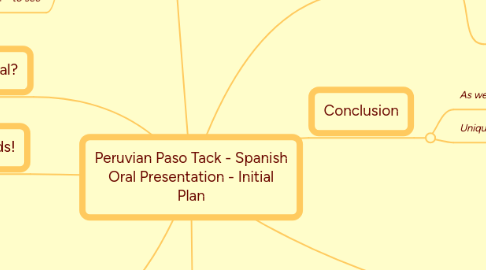
1. Why is is special?
1.1. Often very ornate, lots of leatherworking detail.
1.1.1. Especially on saddle skirts, guarnición y florón
1.1.2. Artform!
1.2. Techniques often passed down through families, so each leatherworker will produce a slightly different saddle.
1.3. Different style to many other varieties of tack
2. Focus on a particular maker of the tack.
2.1. Researching.
3. Visual aids!
3.1. Pictures
3.2. Anything else?
4. Vocab
4.1. Verbs
4.1.1. Caber -to fit
4.1.2. Construir - to build
4.1.3. Cubrir - to cover
4.1.4. Dar - to give
4.1.5. Decir - to say
4.1.6. Distinguir - to distinguish
4.1.7. Elegir - to choose
4.1.8. Entender - to understand
4.1.9. Estar - to be
4.1.10. Haber - to have
4.1.11. Hablar - to speak
4.1.12. Hacer - to do/to make
4.1.13. Hay - there is/are
4.1.14. Ir - to go
4.1.15. Mover - to move
4.1.16. Pensar - to think
4.1.17. Poder - to be able
4.1.18. Poner - to put
4.1.19. Querer - to want
4.1.20. Reunir - to put together
4.1.21. Romper - to break
4.1.22. Saber - to know
4.1.23. Sentir - to feel
4.1.24. Ser - to be
4.1.25. Tener - to have
4.1.26. Ver - to see
5. History
5.1. Origin in 15th century Europe, brought over by Conquistadores
5.2. Adapted to Peruvian needs: comfort for long rides, as horses mostly used for transport.
5.3. Also adapted to mountainous regions, so stable for both horse/rider
6. Consists of... (too much in this section?)
6.1. Saddle
6.1.1. la silla (de montar)
6.1.2. la montura de cajón (box saddle)
6.2. Braided headgear
6.2.1. el jato
6.2.2. Three pieces of bridle: eye cover (tapa ojos), bozalillo (small bosal), bit (freno o bocado).
6.2.3. Una jaquima (halter) y una brida (bridle).
6.2.4. Braided reins (reindas)
6.2.5. Una jaquima (halter) y una brida (bridle).
6.3. Cinch
6.3.1. la cincha
6.3.2. Holds saddle in place
6.4. Crupper
6.4.1. Held to tailpiece with piece of leather called una cruzeta.
6.4.2. La anca, la grupa, la baticola.
6.5. Breeching
6.5.1. guarnición
6.5.2. Consist of long leather straps (retrancas), that go under tail, and two lateral straps (caidas) attached to the base of the tail guard
6.6. El Pellon
6.6.1. Tapestry put over saddle, sign of wealth
6.7. La Carona
6.7.1. Thick leather pad between saddle and blanket
6.8. Tail cover
6.8.1. florón
6.8.2. Elongated leather piece fixed to back of saddle
6.9. Stirrups
6.9.1. Consists of metal cover in the shape of a bell (campaña) and a ring to which the stirrup strap is attached. Covered with metal pieces (punteras).
6.9.2. Most common used woods are olive and algarobbo
6.9.3. los estribos
6.10. Cuero
6.10.1. leather
7. Introduction
7.1. Peruvian Paso
7.1.1. Paso del Peruano
7.1.2. Specific breed from Peru, now exported to US/Europe
7.1.2.1. Specially gaited
7.1.2.2. And!
7.1.2.2.1. Specific tack
8. Conclusion
8.1. As we can see...
8.1.1. Como nos ver (?)
